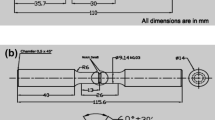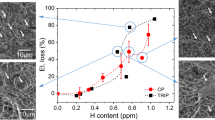Abstract
In this study, the effect of hydrogen on fatigue strength of high strength steels in the very high cycle fatigue regime was further discussed. It is found that the calculated results of fatigue strength by modified Murakami’s expression are in good accordance with the experimental results in ±15% error band. The relationship between fatigue life (N f) and the ratio of granular-bright facet (GBF) to inclusion size \( \left({\frac{{\sqrt {A_{\text{GBF}} } }}{{\sqrt {A_{\text{inc}} } }}}\right) \) for quenching and tempering (QT) specimens and pre-charged specimens by soaking (SK) and cathodic (CD) charging can be approximately expressed by \( {\frac{{\sqrt {A_{\text{GBF}} } }}{{\sqrt {A_{\text{inc}} } }}} = {\frac{{R_{\text{GBF}} }}{{R_{\text{inc}} }}} = 0. 2 5N_{\text{f}}^{ 0. 1 2 5} \); however, the value of \( {\frac{{\sqrt {A_{\text{GBF}} } }}{{\sqrt {A_{\text{inc}} } }}} \) for specimens pre-charged by high-pressure thermal hydrogen charging is obviously greater than that for QT specimens and pre-charged specimens by SK and CD charging at an identical N f. The stress intensity factor range at the periphery of the GBF, ΔK GBF, was calculated in this work. It is found that the value of ΔK GBF is not a constant but approximately proportional to \( (\sqrt {A_{\text{GBF}} } )^{ 1/ 3} \). Besides it is also found that ΔK GBF decreases with the increase of hydrogen content.










Similar content being viewed by others
References
Yang ZG, Li SX, Zhang JM, Li GY, Li ZB, Hui WJ, Weng YQ (2004) Acta Mater 52:5235
Murakami Y, Nomoto T, Ueda T (2000) Fatigue Fract Eng Mater Struct 23:893
Murakami Y, Nomoto T, Ueda T (2000) Fatigue Fract Eng Mater Struct 23:903
Murakami Y (2002) Metal fatigue: effects of small defects and nonmetallic inclusions. Elsevier, Amsterdam & Boston, p 273
Shiozawa K, Lu L, Ishihara S (2001) Fatigue Fract Eng Mater Struct 24:781
Shiozawa K, Morii Y, Nishino S, Lu L (2006) Int J Fatigue 28:1521
Yang ZG, Li SX, Liu YB, Li YD, Li GY, Hui WJ, Weng YQ (2008) Int J Fatigue 30:1016
Garet M, Brass AM, Haut C, Guttierez-Solana F (1998) Corros Sci 40:1073
Oriani RA, Hirth JP, Smialowski M (1985) Hydrogen degradation of ferrous alloys. Noyes Publ, Park, Ridge
Li YD, Yang ZG, Li SX, Liu YB, Chen SM, Hui WJ, Weng YQ (2009) Adv Eng Mater 11(7):561
Li YD, Yang ZG, Li SX, Li SX, Li GY, Hui WJ, Weng YQ (2008) Mater Sci Eng A 498:373
Yang ZG, Zhang JM, Li SX, Li GY, Wang QY, Hui WJ, Weng YQ (2006) Mater Sci Eng A 427:167
Murakami Y (2002) Metal fatigue: effects of small defects and nonmetallic inclusions. Elsevier, Amsterdam & Boston, p 94
Oriani RA, Hirth JP, Smialowski M (1985) Hydrogen degradation of ferrous alloys. Noyes Publ., Park Ridge, p 718
Onyevuenyi OA, Hirth JP (1981) Scr Met 115:113
Chapetti MD, Tagawa T, Miyata T (2003) Mater Sci Eng A 356:236
Bathias C (1999) Fatigue Fract Eng Mater Struct 22:559
Murakami Y (2002) In: Proceeding of the eighth international fatigue congress (Fatigue 2002), EMAS Ltd., vol 5, p 2927
Murakami Y, Yokoyama NN, Kenichi T (2001) J Soc Mater Sci Jpn 50(11):1068
Murakami Y, Yokoyama NN, Nagata J (2002) Fatigue Fract Eng Mater Struct 25:735
Murakami Y (2002) Metal fatigue: effects of small defects and nonmetallic inclusions. Elsevier, Amsterdam & Boston, p 17
Sakai T, Sato Y, Oguma N (2002) Fatigue Fract Eng Mater Struct 25:765
Nakajima M, Kamiya M, Itoga H, Tokaji K, Ko HN (2006) Int J Fatigue 28:1540
Liu YB, Yang ZG, Li YD, Chen SM, Li SX, Hui WJ, Weng YQ (2008) Mater Sci Eng A 497:408
Acknowledgement
This work was financially supported by key project of basic research of China (2004CB619100). The authors wish to thank Prof. L. J. Rong, Dr. J. Zhang, and Prof. G. Y. Li for their useful advice and experimental supports.
Author information
Authors and Affiliations
Corresponding author
Rights and permissions
About this article
Cite this article
Li, Y.D., Chen, S.M., Liu, Y.B. et al. The characteristics of granular-bright facet in hydrogen pre-charged and uncharged high strength steels in the very high cycle fatigue regime. J Mater Sci 45, 831–841 (2010). https://doi.org/10.1007/s10853-009-4007-5
Received:
Accepted:
Published:
Issue Date:
DOI: https://doi.org/10.1007/s10853-009-4007-5




